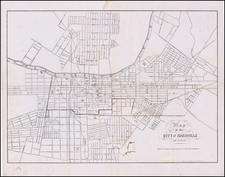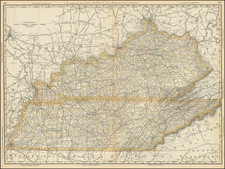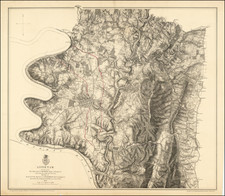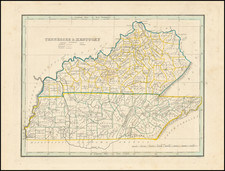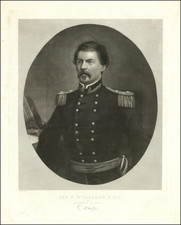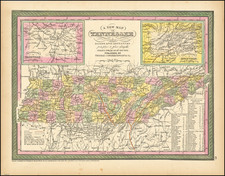The Battle of Battle of Fort Donelson and Capture of General Simon Bolivar Buckner and his army on February 16, 1862
This striking chromolithographic print of the Battle of Fort Donelson, Tennesse by Kurz & Allison illustrates a significant battle in the early parts of the American Civil War.
The print vividly details the Union Troops on the left, advancing upon Confederate troops near the Cumberland River, a crucial waterway during the conflict. The inclusion of wounded soldiers being treated in the foreground adds a human element to the scene, while mounted commanders at the far left oversee the action. A Union flag bearer stands at the center, symbolizing unity and resolve. Steamships are depicted on the Cumberland River at the top right, a strategic point that played a vital role in the battle.
Battle of Fort Donelson
The Battle of Fort Donelson itself took place from February 11 to 16, 1862, near the towns of Dover and Fort Donelson in Tennessee, close to the Kentucky border. The Union's capture of the Confederate fort opened the Cumberland River, an essential avenue for the invasion of the South, allowing access to important locations such as Nashville.
Commanding the Union forces was Brig. Gen. Ulysses S. Grant, who conducted probing attacks and coordinated with Union gunboats under Flag Officer Andrew H. Foote. The Confederate side was led initially by Brig. Gen. John B. Floyd, followed by Brig. Gen. Gideon Johnson Pillow and later Brig. Gen. Simon Bolivar Buckner. The surprise Confederate attack to open an escape route to Nashville and subsequent retreat back to the fort added complexity to the battle.
The capture of General Simon Bolivar Buckner and his army on February 16, 1862, at the Battle of Fort Donelson marked a critical moment in the American Civil War. Following a failed breakout attempt on the previous day, Confederate commanders Floyd and Pillow escaped, leaving Buckner in command. Facing an overwhelming Union force and recognizing the futility of further resistance, Buckner sent a message to Grant requesting terms for a surrender. Grant's firm response demanded "unconditional and immediate surrender," and Buckner accepted the terms, resulting in the capture of approximately 12,000 to 15,000 Confederate soldiers. This marked one of the largest surrenders of Confederate forces during the war.
The strategic importance of this battle extended far beyond the capture of a large number of troops. The Union's success at Fort Donelson opened the Cumberland River, an essential transportation route that allowed the Union forces to penetrate deeper into Confederate territory, setting the stage for further advances in Tennessee and the broader South. The fall of Fort Donelson also led directly to the capture of Nashville, a vital industrial and transportation hub for the Confederacy. The loss of this city was a significant blow, impacting the Confederacy's ability to manufacture and transport essential war materials.
Moreover, the decisive victory at Fort Donelson provided a much-needed boost to Union morale, which had been wavering after earlier setbacks in the war. The capture of a significant Confederate force, including a General, was a potent symbol of Union strength and determination. The battle also served to elevate the profile of Ulysses S. Grant. His firm stance in demanding unconditional surrender earned him the nickname "Unconditional Surrender" Grant and marked the beginning of his rise as one of the Union's foremost commanders.
Naval Battle
The naval operations during the Battle of Fort Donelson were a critical part of the Union's strategy, and the depiction of steamships in the Kurz & Allison chromolithographic print reflects this essential component of the battle.
The Cumberland River, where the battle took place, was a vital artery for transportation and commerce. Gaining control of the river would open up an avenue for the invasion of the South and provide the Union forces with access to critical locations like Nashville.
On February 14, 1862, Union gunboats, including four ironclad warships, attempted to reduce Fort Donelson with gunfire. Led by Flag Officer Andrew H. Foote, who commanded the Western Gunboat Flotilla, this naval assault aimed to weaken the fort's water batteries and pave the way for the land forces to move in. The ironclads, heavily armored steam-propelled ships, were a significant innovation in naval warfare at the time.
However, the naval assault met with strong resistance. The Confederate artillery was well-prepared and heavily armed, inflicting significant damage on the Union ships and forcing them to withdraw. Although the direct naval assault on Fort Donelson was repelled, the presence of the Union gunboats and the overall naval strategy played a critical role in the subsequent land battle. The threat posed by the naval forces contributed to the Confederate decision to attempt a breakout, which eventually led to their defeat.
The steam-powered gunboats and ironclads introduced during the Civil War represented a new era in naval warfare. Their use at Fort Donelson demonstrated the potential of steam power and iron armor, heralding a shift in naval technology and tactics that would have a lasting impact on naval strategy.
Kurz & Allison
Kurz & Allison, known for their work on American historical scenes, especially Civil War battles, produced this print. The Chicago-based firm created 36 chromolithographs of Civil War events, characterized by their use of bright colors and a broad graphic style. Their works, such as this print, serve as both historical documents and decorative pieces, connecting the past with the present.









